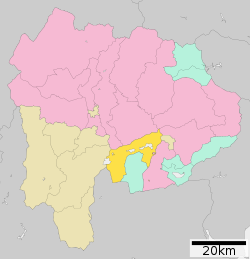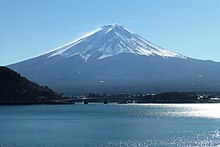Fujikawaguchiko(Phú sĩ hà khẩu hồ đinh,Fujikawaguchiko-machi)is atownlocated inYamanashi Prefecture,Japan.As of 1 June 2019[update],the town had an estimatedpopulationof 26,542 in 10,618 households,[1]and apopulation densityof 170 persons per km2.The total area of the town is 158.40 square kilometres (61.16 sq mi).
Fujikawaguchiko
Phú sĩ hà khẩu hồ đinh | |
|---|---|
 Location of Fujikawaguchiko in Yamanashi Prefecture | |
| Coordinates:35°29′50.1″N138°45′17.8″E/ 35.497250°N 138.754944°E | |
| Country | Japan |
| Region | Chūbu Tōkai |
| Prefecture | Yamanashi Prefecture |
| District | Minamitsuru |
| Government | |
| • Mayor | Hideyuki Watanabe |
| Area | |
• Total | 158.40 km2(61.16 sq mi) |
| Population (June 1, 2019) | |
• Total | 26,540 |
| • Density | 170/km2(430/sq mi) |
| Time zone | UTC+9(Japan Standard Time) |
| Phone number | 0555-72-1111 |
| Address | 1700 Funatsu, Fujikawaguchiko-machi Minimitsuru-gun, Yamanashi-ken 401-0392 |
| Climate | Cfa |
| Website | Official website |
| Symbols | |
| Bird | Varied tit |
| Flower | Oenothera |
| Tree | Japanese red pine |

Geography
editFujikawaguchiko is located in southern Yamanashi Prefecture, in the foothills ofMount Fuji.Three of theFuji Five Lakes(Lake Kawaguchi,Lake SaiandLake Shōji) are located in Fujikawaguchiko.Lake Motosuis shared with neighboringMinobu.
Neighboring municipalities
editYamanashi Prefecture:
Climate
editFujikawaguchiko features ahumid continental climate(KöppenDfa,bordering onDfb) that closely borders on ahumid subtropical climate(KöppenCfa) and anoceanic climate(KöppenCfb). The average annual temperature in Fujikawaguchiko is 10.3 °C. The average annual rainfall is 1663 mm with September as the wettest month.[2]
| Climate data for Lake Kawaguchi (1991−2020 normals, extremes 1933−present) | |||||||||||||
|---|---|---|---|---|---|---|---|---|---|---|---|---|---|
| Month | Jan | Feb | Mar | Apr | May | Jun | Jul | Aug | Sep | Oct | Nov | Dec | Year |
| Record high °C (°F) | 19.5 (67.1) |
20.2 (68.4) |
23.3 (73.9) |
29.9 (85.8) |
30.5 (86.9) |
33.4 (92.1) |
35.3 (95.5) |
35.0 (95.0) |
33.0 (91.4) |
29.7 (85.5) |
23.9 (75.0) |
21.2 (70.2) |
35.3 (95.5) |
| Mean daily maximum °C (°F) | 5.5 (41.9) |
6.6 (43.9) |
10.5 (50.9) |
16.1 (61.0) |
20.6 (69.1) |
23.0 (73.4) |
27.2 (81.0) |
28.1 (82.6) |
23.8 (74.8) |
18.3 (64.9) |
13.8 (56.8) |
8.5 (47.3) |
16.8 (62.3) |
| Daily mean °C (°F) | −0.4 (31.3) |
0.6 (33.1) |
4.2 (39.6) |
9.5 (49.1) |
14.3 (57.7) |
17.8 (64.0) |
21.9 (71.4) |
22.5 (72.5) |
18.7 (65.7) |
13.0 (55.4) |
7.5 (45.5) |
2.3 (36.1) |
11.0 (51.8) |
| Mean daily minimum °C (°F) | −5.7 (21.7) |
−4.8 (23.4) |
−1.3 (29.7) |
3.7 (38.7) |
8.9 (48.0) |
13.7 (56.7) |
18.0 (64.4) |
18.5 (65.3) |
14.8 (58.6) |
8.7 (47.7) |
2.2 (36.0) |
−2.9 (26.8) |
6.1 (43.1) |
| Record low °C (°F) | −22.1 (−7.8) |
−20.5 (−4.9) |
−18.1 (−0.6) |
−9.1 (15.6) |
−3.0 (26.6) |
3.5 (38.3) |
4.2 (39.6) |
9.3 (48.7) |
2.3 (36.1) |
−3.3 (26.1) |
−9.5 (14.9) |
−15.5 (4.1) |
−22.1 (−7.8) |
| Averageprecipitationmm (inches) | 60.9 (2.40) |
55.4 (2.18) |
107.6 (4.24) |
106.1 (4.18) |
123.2 (4.85) |
157.1 (6.19) |
178.4 (7.02) |
176.8 (6.96) |
264.7 (10.42) |
230.0 (9.06) |
76.0 (2.99) |
49.8 (1.96) |
1,585.9 (62.44) |
| Average snowfall cm (inches) | 37 (15) |
28 (11) |
20 (7.9) |
4 (1.6) |
0 (0) |
0 (0) |
0 (0) |
0 (0) |
0 (0) |
0 (0) |
1 (0.4) |
7 (2.8) |
97 (38) |
| Average precipitation days(≥ 1.0 mm) | 4.9 | 5.1 | 9.1 | 8.5 | 9.4 | 11.5 | 11.7 | 10.1 | 11.1 | 10.1 | 6.7 | 4.6 | 102.8 |
| Average snowy days(≥ 1 cm) | 4.4 | 4.3 | 3.1 | 0.7 | 0 | 0 | 0 | 0 | 0 | 0 | 0 | 1.2 | 13.7 |
| Averagerelative humidity(%) | 62 | 63 | 67 | 68 | 73 | 80 | 81 | 81 | 82 | 81 | 74 | 66 | 73 |
| Mean monthlysunshine hours | 212.3 | 190.7 | 185.7 | 185.5 | 181.0 | 122.8 | 148.4 | 165.2 | 122.5 | 134.4 | 165.8 | 199.9 | 2,014.2 |
| Source:Japan Meteorological Agency[3][4] | |||||||||||||
Demographics
editPer Japanese census data,[5]the population of Fujikawaguchiko grown slightly in recent decades.
| Year | Pop. | ±% |
|---|---|---|
| 2000 | 23,824 | — |
| 2010 | 25,471 | +6.9% |
| 2020 | 26,082 | +2.4% |
History
editThe area around Lake Kawaguchi has been inhabited since at least theJōmon period.It was on the road connectingKai ProvincewithSuruga Province,and is mentioned inHeian periodrecords, which also document an eruption of Mount Fuji in 864 AD. During theEdo period,all of Kai Province wastenryōterritory under direct control of theTokugawa shogunate.During the cadastral reform of the earlyMeiji periodon July 1, 1889, the area came under the jurisdiction of Minamitsuru District, Yamanashi Prefecture.
On 15 November 2003, the town ofKawaguchiko,and the villages ofKatsuyamaandAshiwadamerged to form the new town of Fujikawaguchiko. The headquarters of the infamousAum Shinrikyowas located in the village ofKamikuishiki,most of which was absorbed into Fujikawaguchiko on 1 March 2006.
In May 2024, Fujikawaguchiko erected a large black barrier to block the iconic view of Mount Fuji due to a surge in tourists drawn by the town's popularity on social media platforms like Instagram. Installed on May 21, this measure followed complaints of disruptive behavior from tourists, including harassment of locals, littering, and trespassing. Even businesses unrelated to tourism, such as a dental clinic, had been affected, prompting them to seek intervention from local authorities. Unlike specific attractions, Fujikawaguchiko's issue stems from a viewpoint favored for capturing Mount Fuji, located in front of a convenience store. Most visitors opt for day trips, contributing to traffic congestion and environmental damage without significant financial benefits to the town.[6]
Education
editFujikawaguchiko has eight public elementary schools and two public junior high schools operated by the town government, along with one private elementary school and one private junior high school. The town has one public high school operated by the Yamanashi Prefectural Board of Education. TheHealth Science University,a private medical school, is located in Fujikawaguchiko.
Transportation
editRailway
editHighway
editLocal attractions
edit- The toy museum of Teruhisa Kitahara
- Fuji Five Lakes
- The sound of wild birds atLake Saiwas designated as one of the100 Soundscapes of Japanby theMinistry of the Environment[7]
References
edit- ^Fujikawaguchiko town official statistics(in Japanese)
- ^"Fujikawaguchiko climate: Temperature Fujikawaguchiko & Weather By Month".en.climate-data.org.Retrieved2023-10-16.
- ^Quan trắc sử thượng 1~10 vị の trị ( niên gian を thông じての trị ).JMA.RetrievedMarch 4,2022.
- ^Khí tượng sảnh / bình niên trị ( niên ・ nguyệt ごとの trị ).JMA.RetrievedMarch 4,2022.
- ^"Yamanashi (Japan): Cities, Towns and Villages in Prefecture - Population Statistics, Charts and Map".www.citypopulation.de.Retrieved2023-10-16.
- ^Marcus, Lilit (2024-05-21)."Japanese town overrun with tourists puts up view-blocking barrier near Mount Fuji".CNN.Retrieved2024-05-24.
- ^"100 Soundscapes of Japan".Ministry of the Environment.Retrieved8 December2015.
External links
editMedia related toFujikawaguchiko, Yamanashiat Wikimedia Commons
- Official Website(in Japanese)








